Brilliant, charismatic and rebellious are the adjectives that characterize Pablo Picasso (Malaga 1881 - Mougins 1973), one of the most influential and revolutionary painters in the history of Western art. Revealed as an enfant prodige from an early age, he demonstrated his talent for drawing, so much so that his father (a modest painter and teacher at the Barcelona Academy) let him collaborate on some of his paintings. The Spanish painter’s artistic output was particularly vast and complex. As difficult as it may be to delineate constant elements in the style of such a prolific artist, there are components that characterized his style: clarity and balance in compositions, solid forms and volumes, great sense of color and expressive power.
Picasso was an artist who was never content to land on a specific style. As unpredictable in his soul as he was in his art, the Andalusian artist had several artistic phases: from the blue period (1901-1904), to the pink period (1904-06), the birth of cubism thanks to his association with George Braque, and then returning to a more traditional style of painting, while the last phase is characterized by a very intense activity, also addressing techniques such as ceramics and graphics.
At a very young age he moved to Paris, a stimulating city full of opportunities, where he met artists such as André Derain, Amedeo Modigliani, and Henri Matisse but also wealthy art dealers’art such as Daniel-Henry Kahnweiler, the writer Gertrude Stein, to whom the artist dedicated a portrait that was considered by many, among others, to be a forerunner of Cubism, and the French art dealer with exceptional flair Armbroise Vollard : they are all immortalized by Picasso’s portraits, one of their most promising “discoveries.”
Outside the narrow artistic sphere, Picasso was also famous for his various affairs. In fact, numerous were the Andalusian artist’s mistresses: Fernand Oliver was Picasso’s first true love and appears in more than sixty paintings, among them Les Demoiselles d’Avignon (1906-07); after his breakup with Fernand, the artist met Marcelle Gouel, whom he renamed “Eva,” who likewise appears in many abstract works. His love life was, in fact, extremely unstable and stormy, punctuated by the succession of different loves and inspiring muses.
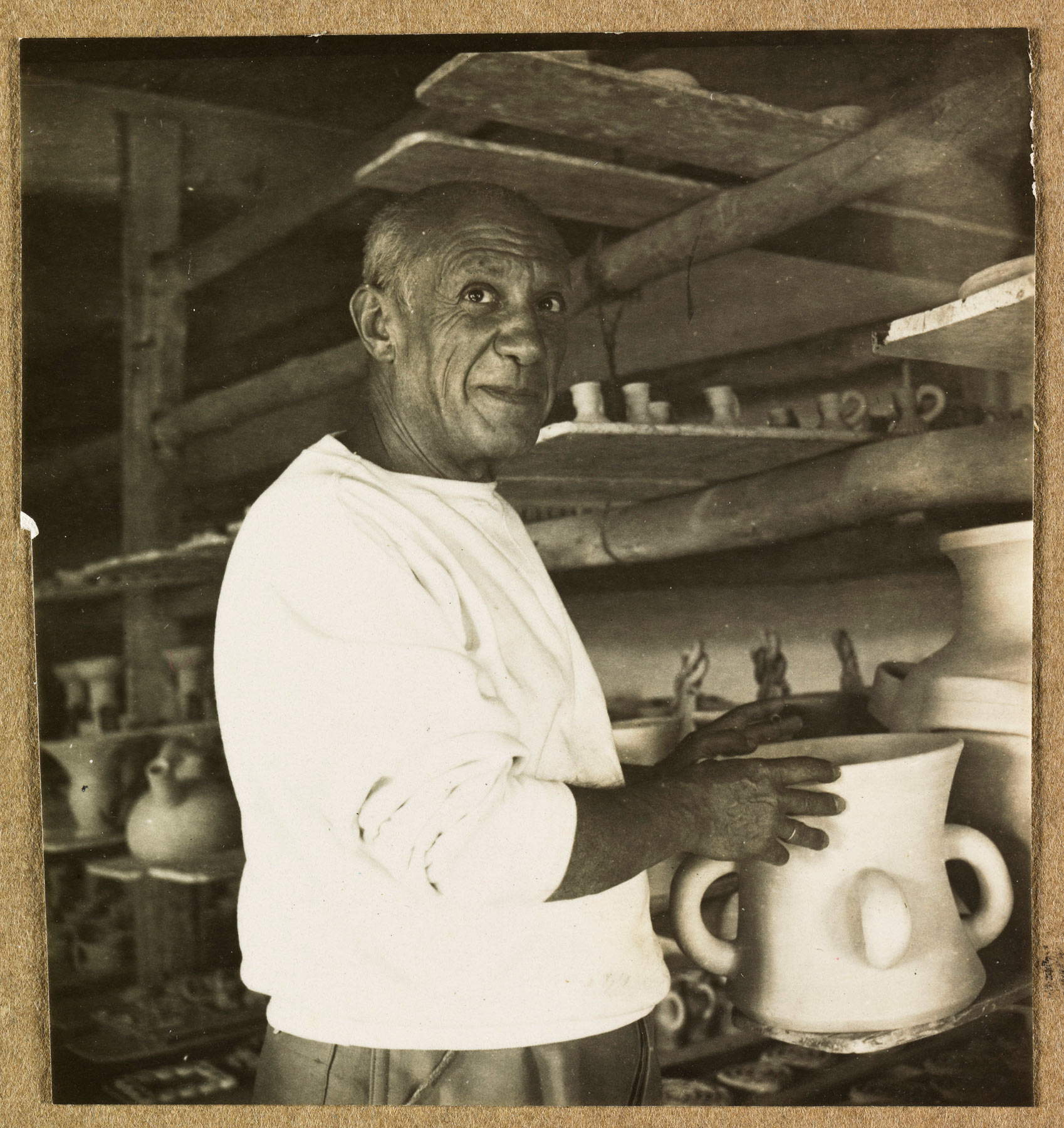 |
| Pablo Picasso |
Pablo Picasso was born in Malaga on October 25, 1881, the first son of naturalist painter José Ruiz and Maria Picasso y López. At a very young age he began drawing and from 1901 would sign his name with his mother’s surname, a decision that sealed a very strong sign of affection for his mother figure. As a teenager he moved with his family to Barcelona, where he began to take an interest in the city’s intellectual life: here he frequented a group of young artists who met in the local Els quatre gats, and although the Spanish intellectual circle was stimulating enough, Picasso felt an increasing need to escape from an environment whose limitations he felt.
As soon as he was nineteen years old, the young artist left Barcelona for the bohemian life between Montmartre and Montparnasse in Paris: the glittering streets, the deafening hubbub of the markets and the din of horse carriages, the cafés and boulevards fascinated Picasso and made him feel at home. In 1904 he moved permanently to the French capital, renting an old factory in Montmartre, later converted into an artists’ atelier: it was the Bateau-Lavoir, which, thanks to Picasso’s charismatic presence, became a studio frequented by several prominent personalities. At the beginning of his stay Picasso shared a room with the poet Max Jacob, a relevant figure in Picasso’s life, as he supported him both in his artistic life and in his initial economic difficulties. The French environment was extremely stimulating for the young artist, who began to frequent Parisian salons, where he got to know the poet Guillaume Apollinare, author of The Cubist Painters, in 1913. The Andalusian artist’s style was beginning to show specific and original traits. Thus began the so-called blue period, characterized by monochromatic works, such as Life (1903) or The Old Guitarist (1903) in which blue was used in all its possible shades and hues. This color was employed not only for its expressive force, but also for the melancholic and dramatic valence it could emanate. This phase was followed by the pink period (1904-06): the canvases, now brighter like The Family of Acrobats (1905), are populated with circus characters, such as acrobats, street musicians and harlequins. The predominant tones are pink, ochre and pastel colors, evoking a more serene atmosphere, although a vaguely melancholy note remains.
The real artistic turning point came in 1907 with Les Demoiselles d’Avignon , which paved the way for a real artistic shift destined to change the future of art history. With this great painting Picasso opened his Cubist season, maintaining an ongoing dialogue with the works of Paul Cézanne. The work kicked off a long quest for multiple expressive possibilities realized through the decomposition of volumes and the schematic treatment of planes. During this period, the artist was in close contact with Georges Braque, with whom he shared artistic pursuits: together the two gave rise to works with many similarities. In 1912 Cubism reached its zenith; the figures were fragmented, thus producing a multitude of viewpoints. The introduction of papier collè (a painting technique of gluing different materials together) and collage (superimposition of paper materials) assumed great importance in this process. Also in the same year Picasso met the beautiful and future muse Marcelle Hubert, whom he called Eva, and to indicate his love for her the words “I love eva” appear on many paintings of the Cubist period. Eva fell ill with tuberculosis and soon after died, which was a blow to the artist.
In 1915 he met Olga Kokhlova, who became his wife and muse: their union gave birth to their son Paulo. Between 1914 and 1918 we see a period of transition: these were the years of World War I, and while Picasso continued to experiment, he seemed to return to more traditional painting. His works at the time recalled those of the great masters of the Italian Renaissance, especially Raphael, but also the neoclassical canvases of Jean-Auguste-Dominique Ingres. In 1936 civil war broke out in Spain and Picasso sympathized with the Republicans, in the name of his love of freedom, against General Franco’s fascists. 1937 was the year dedicated to the Universal Exhibition in Paris, for which the Spanish artist created the large painting Guernica, which depicts the bombing and destruction of the small Spanish town Guernica by the Nazi-Fascists who supported the Franco army and carpet-bombed it .
After the liberation of Paris at the end of World War II, Pablo became involved with the young art student Françoise Gilot, by whom he had two children, Pablo and Paloma. Françoise was the only woman to leave him, tired of his infidelities. In the years following World War II, Picasso, after painting a masterpiece such as Joie de vivre (1946-1948) that ushered in a more carefree season of his career, devoted himself to ceramics(read more about Picasso’s ceramics here) and sculpture, while his pictorial works were characterized by “d’après” works, or personal interpretations of famous paintings. By 1950, Pablo Picasso was a famous and celebrated artist in museums around the world. The artist died in Mougins on April 8, 1973 at the age of 91. In 2003 the Picasso Museum was opened in Malaga(read more about the Picasso Museum in Malaga here), which houses more than two hundred works by the Spanish artist on permanent display. His works are now being auctioned in the largest auction houses for millions of dollars.
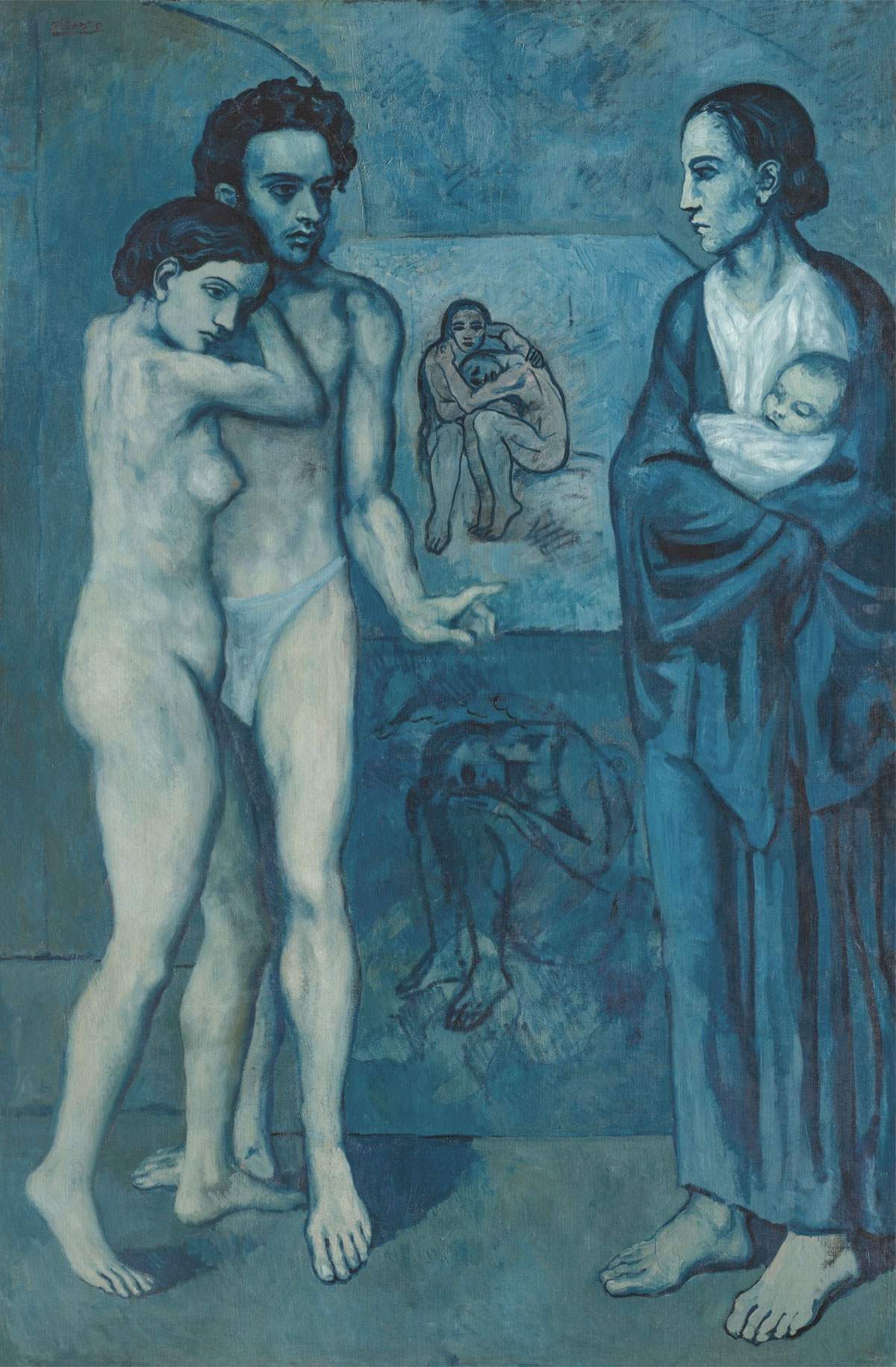 |
| Pablo Picasso, Life (1903; oil on canvas, 197 x 127.5 cm; Cleveland, Cleveland Museum of Art) |
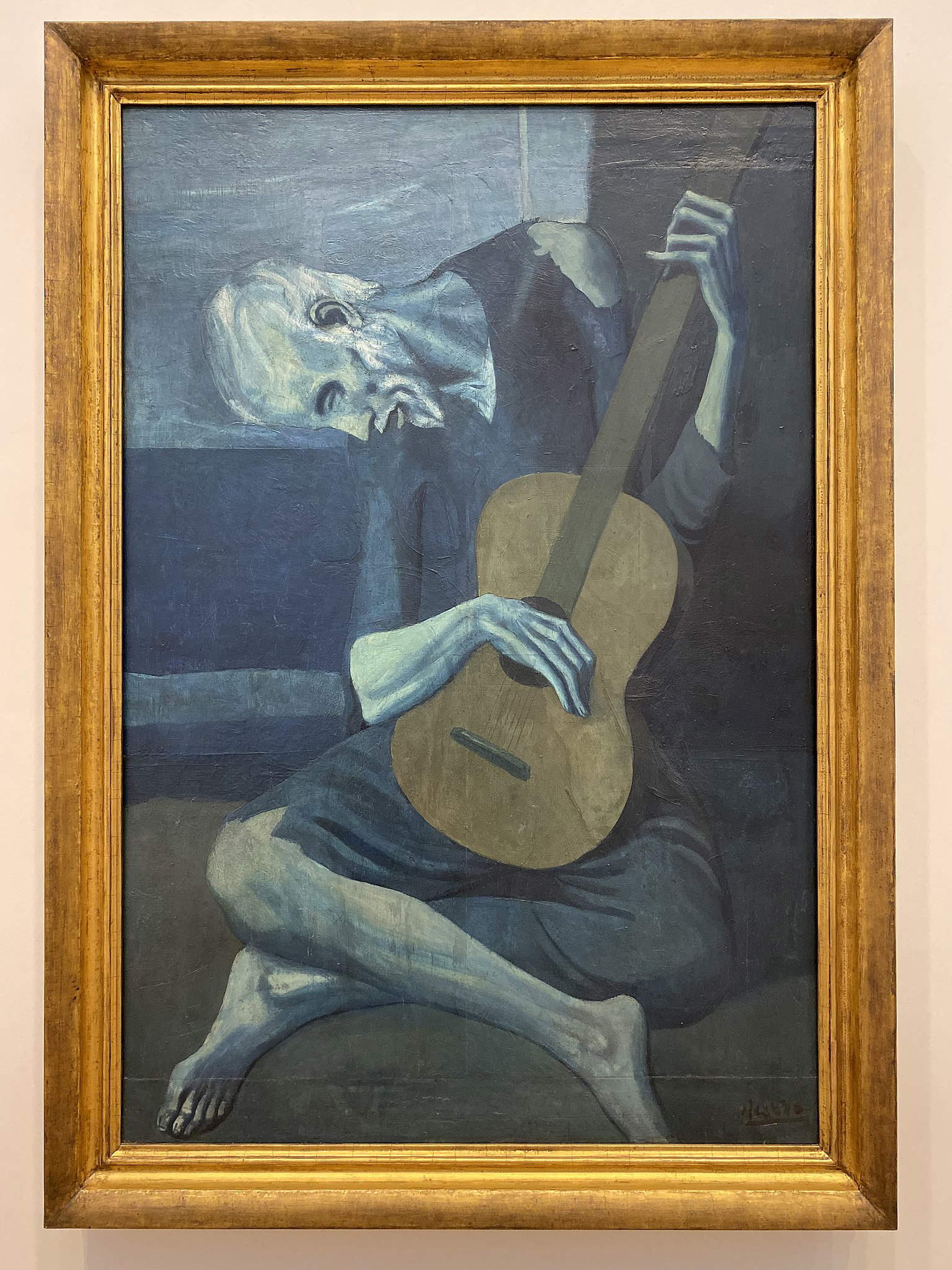 |
| Pablo Picasso, Old Guitarist (1903; oil on canvas, 121 x 92 cm; Chicago, The Art Institute) |
 |
| Pablo Picasso, Les Demoiselles dAvignon (1907; oil on canvas, 243.9 x 233.7 cm; New York, Museum of Modern Art) |
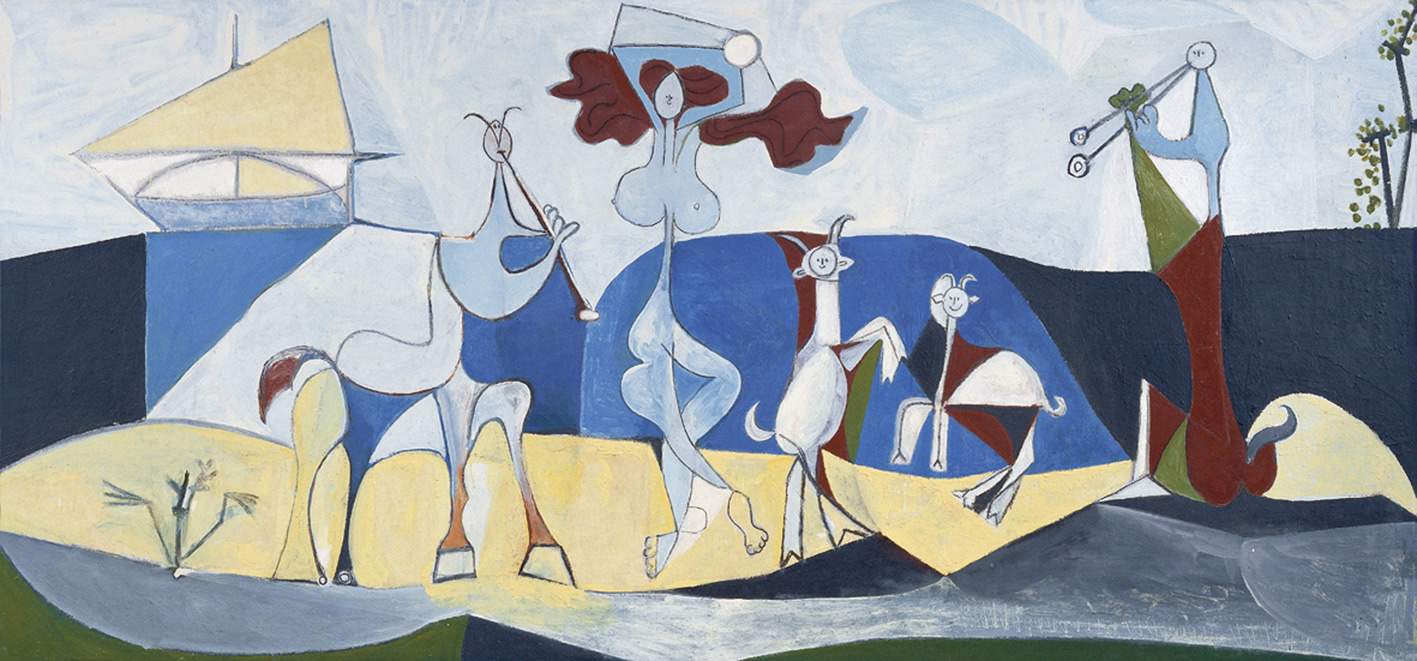 |
| Pablo Picasso, La joie de vivre (1946-1948; ripolin paint and charcoal on fiber cement, 120 x 250 cm; Antibes, Musée Picasso) |
Picasso’s artistic output was one of the most prolific and varied of the twentieth century: in fact, throughout his career the artist went through numerous stylistic changes and proved himself to be a multifaceted artist capable of dealing with any artistic expression. His paintings were closely related to his life experiences. A group of drawings and several sketches composed Picasso’s first exhibition: the display was set up on the walls of an art-literary venue Els Quatre Gats in 1897 in Barcelona. The venue was frequented by intellectuals and artists who represented a new orientation in Barcelona’s art circles. It was at this club that the Andalusian artist met the painter and poet Carlos Casagemas, with whom in the fall of 1900 he decided to leave for the then capital of art: Paris. Here, the museums and merchants’ galleries gave Picasso the opportunity to see the work of Ingres, Delacroix, Van Gogh and Toulouse - Lautrec. Despite the brevity of his stay, the artist found time to paint several paintings that testify to his quick ability to assimilate new influences, such as the 1900 work Les Moulins de la Galette , which is in the Impressionist tradition. The canvas depicts a room crowded with dancing couples; the surface has been treated by fluid brushstrokes with vivid colors. Light seems to come from the color of the ladies’ skirts and their flamboyant hats, as well as in the festoons in the background and the lights that characterize these typical Parisian settings. The technique of the Impressionists was appropriated by Picasso, who quickly demonstrated his ability to master a new style.
The opportunity for his first Parisian exhibition was granted him by the merchant and gallery owner Ambroise Vollard, who had a store on Rue Laffitte, a street that became famous for galleries devoted to avant-garde painters. Vollard was a friend and supporter of painters whose names were among the most distinguished of his time and whom Picasso came to know precisely because of Vollard: these included Cézanne. The exhibition in Vollard’s gallery aroused the interest of only a few critics and collectors, but it was the source of new friendships, such as that with the mystic poet Max Jacob.
In the early twentieth century Picasso began to show symptoms of depression, following the suicide of his friend Carlos Casagemos. This period coincided with the blue phase: the painter’s delicate psychological balance translated on canvas. In fact, blue took on a melancholic, poetic, almost sacred significance; it became a sort of projection of his own inner malaise. The subjects of his canvases from this phase are poor and marginalized, whose despair and melancholy is both social and mental. The most important painting of this period is certainly Life (1903): the allegory the artist wanted to express is not easy to read. The stiffness of the figures suggests that they stand for expressing the incompatibility between life and sexual love. The painting could also refer to the theme of life being governed by a daily and inevitable malaise and can be faced alone or as a couple. From the same period, The Old Chiarist (1903): there are few elements in the painting, the focus is all on the old blind man, who playing the guitar seems to have no more strength to live. One can see from these two examples the strong sadness and poverty that characterized this period and, above all, the ability of an artist who, at only twenty-two years old, was able to translate into visual form sensations and awareness that were not easy to process. In the period that followed (1904-06), pink became the main color of his works. Here the main lesson seems to be that of Henri de Toulouse - Lautrec, losing, however, the lightness and pleasant aspects of the French artist. In the pink period Picasso manifested a renewed interest in volume and space, although melancholy was always present. Redeeming poverty remained only the bonds of affection, as in the many depictions of the street thespians: The Family of Acrobats (1905) in which a group of circus performers pose surrounded by a timeless landscape; the characters seem like icons of marginalization, they become symbols of human suffering, but unlike the characters of the blue period, the acrobats depicted here do not manifest excessive sadness, it is rather the emptiness that surrounds them that arouses a feeling of loneliness and alienation, as in The Boy with a Pipe ( 1905). The work achieved great notoriety because it was the highest paid painting at public auction of all time: in fact, in 2004 it exceeded $100 million and remains one of the few paintings of the rose period in private hands.
In the years to follow, the paintings would become increasingly dry, the lines more geometric, and the volumes reduced: this is evidenced by Portrait of Gertrude Stein (1906), in which the artist avoided perspective and made the facial features deliberately asymmetrical. The American writer greatly appreciated the gift, which in fact she hung in her living room. In 1907 Picasso deepened his knowledge of African art by visiting the Trocadero Ethnographic Museum, which Pablo had approached thanks to the artist André Derain. The approach to this type of art was of fundamental importance to the artist who, attracted by African masks, would also mention them in Les Demoiselles D’Avignon, (1906-07) a work that has been considered by many art historians to be the manifesto of Cubism. The canvas remained in the artist’s studio for a long time until 1916, although it was seen by many artists who frequented the studio: the five girls look directly at the viewer, so it is as if the viewers are inside the painting and creates a four-dimensional space. The salient node of the work is the intersection of the ancient pictorial tradition of the group of female nudes, with the prosaic theme of the brothel. The image was disconcerting to those accustomed to more traditional painting. In the early twentieth century, in fact, many painters were painting in an Impressionist style. Post-Impressionist artists such as Edvard Munch, Vincent Van Gogh, and Cèzanne certainly experimented a great deal on the painterly and formal level, but the shattering and distorted figures that Picasso presented introduced elements of further novelty.
In 1910 Picasso met George Braque, and together they began to introduce into their paintings the flatness of volumes, the loss of chiaroscuro effects, the progressive reduction of colors, and above all the principle of simultaneity, the trademark of Cubism: this is the superimposition of many points of view in the same image. Portrait of Daniel - Henry Kahnweiler (1910) is a Cubist depiction of Picasso and Braque’s gallerist. The Spanish artist’s main intent was not to recreate an image resembling reality or to “imitate nature,” but to fragment forms and recompose them on canvas: as he wrote in 1923, “art has always been art and not nature.” According to accounts of the time, Kahnweiler posed thirty times, evidence of Pablo’s commitment to elaborating his spatial language.
Picasso conducted pictorial research driven by a rational and scientific intent, as can be seen in another of his works from the Cubist period, Woman with a Mandolin (1910): in the center is a woman, whose figure is composed of simple geometric shapes, overlapping and intersecting volumes, and the mandolin the woman is playing is also distinguishable. Picasso did not stop with the Cubist period. In 1917 he made a trip to Italy with his writer friend Jean Cocteau. The encounter with the Bel Paese pushed the Andalusian artist toward a classicist painting that manifested itself in the depiction of monumental and gentle female figures: an example is Women Dancing on the Beach (1924), a setting inspired by the traditional Bacchae theme. Dated to the early 1920s is the meeting with André Breton, who tried to involve the mature Picasso within the Surrealist movement: however, the artist did not fully adhere, although elements of surrealist poetics can be discerned in the works of those years. The classicist phase was later followed by a more “violent” type of painting. The small Spanish town of Guernica was bombed on April 26, 1937, and in May of that year Picasso worked on Guernica, a large-scale canvas (351x782 centimeters) that the artist made for the Universal Exhibition in Paris. The work has been considered by many to be the summa of his artistic career. The space described is an interior demolished by bombing, the figures bear many references to the classics: in fact, note that the figure of the mother with the child refers to Michelangelo’s Pieta. The painting, which expresses the new link between art and life, form and feeling, is not only a pictorial testimony but a true “manifesto” of politically aligned modern art. Pablo Picasso was one of the most important artists in art history, an artist of extraordinary creativity in his later years he also made plates, vases and sculptures. When at the age of 91 he died, Pablo Picasso was still a master gifted with a creativity that never seemed to run out.
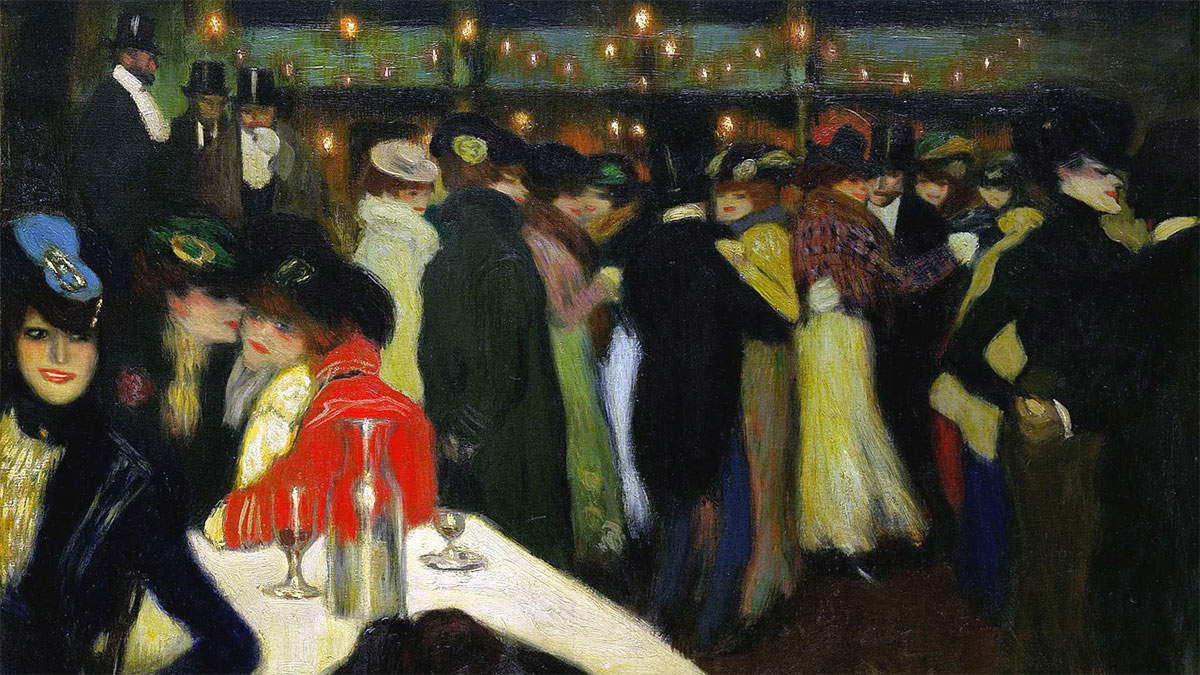 |
| Pablo Picasso, Les Moulins de la Galette (1900; oil on canvas, 88.2 x 115 cm; New York, Guggenheim Museum) |
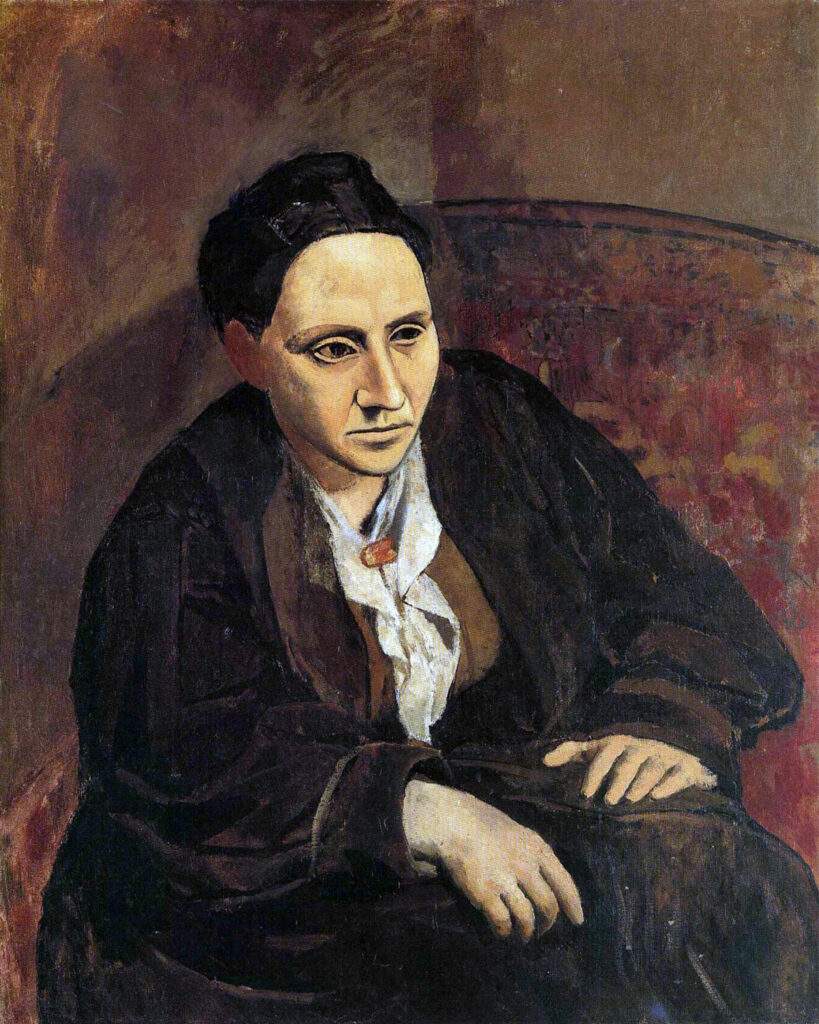 |
| Pablo Picasso, Portrait of Gertrude Stein (1905-1906; oil on canvas, 99.6 x 81.3 cm; New York, Metropolitan Museum) |
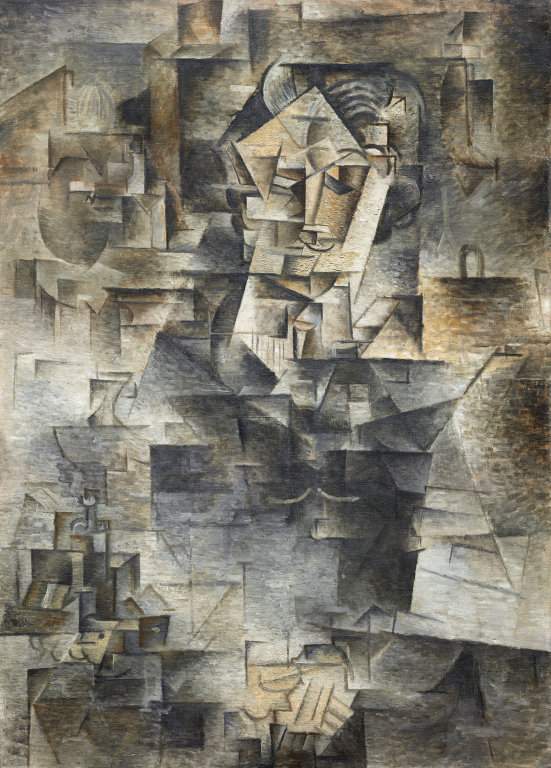 |
| Pablo Picasso, Portrait of Daniel Kahnweiler (1910; oil on canvas, 100.4 x 72.4 cm; Chicago, The Art Institute) |
 |
| Pablo Picasso, Guernica (1937; oil on canvas, 349.3 x 776.6 cm; Madrid, Museo Reina Sofía |
The best-known museum dedicated to the Spanish artist is the Musée Picasso in Paris, which holds about 3,000 works. This abundant collection is the result, of two major donations, one in 1979 and the other in 1990 from his daughter Jacqueline. New acquisitions have since been added over the years; here you can see the Cubist work Still Life with Stuffed Chair (1912) and Women Running on the Beach from 1922. Barcelona, too, has dedicated a museum to the Spanish painter, who lived his formative years here and thus had close ties to the city. Another place to admire the works is the Picasso Museum in Malaga, here in the center of the city the museum is located in a quaint palace. Later restoration works brought to light ancient Phoenician, Roman and Arab remains that can now be admired in the museum’s basement. The museum has more than 200 of the artist’s works on permanent display. Also in Spain, at the Reina Sofia Museum in Madrid it is possible to view the impressive Guernica . In order to look at Les Demoiselles d’Avignon , it is necessary to go overseas to the Museum of Modern Art (MoMa) in New York.
 |
| Pablo Picasso: cubism, life and works |
Warning: the translation into English of the original Italian article was created using automatic tools. We undertake to review all articles, but we do not guarantee the total absence of inaccuracies in the translation due to the program. You can find the original by clicking on the ITA button. If you find any mistake,please contact us.